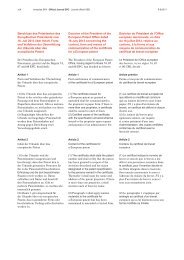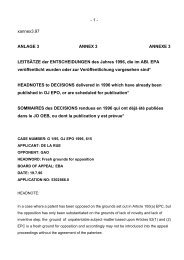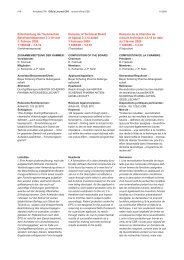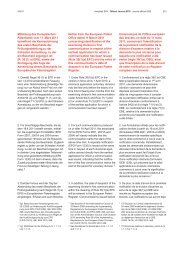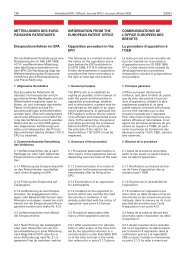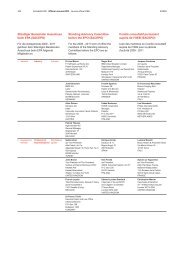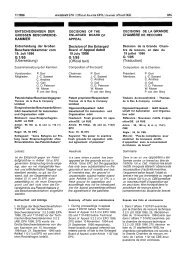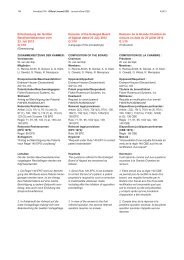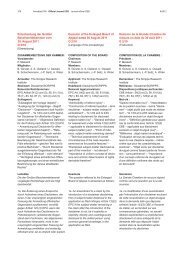Sonderausgabe 1 - European Patent Office
Sonderausgabe 1 - European Patent Office
Sonderausgabe 1 - European Patent Office
You also want an ePaper? Increase the reach of your titles
YUMPU automatically turns print PDFs into web optimized ePapers that Google loves.
2007 <strong>Sonderausgabe</strong> Nr. 1 ABl. EPA / Special edition No. 1 OJ EPO / Edition spéciale n° 1 JO OEB 39<br />
(4) Gehören Stoffe oder Stoffgemische<br />
zum Stand der Technik, so wird ihre<br />
<strong>Patent</strong>ierbarkeit durch die Absätze 2 und<br />
3 nicht ausgeschlossen, sofern sie zur<br />
Anwendung in einem in Artikel 53 c)<br />
genannten Verfahren bestimmt sind und<br />
ihre Anwendung in einem dieser<br />
Verfahren nicht zum Stand der Technik<br />
gehört.<br />
(5) Ebenso wenig wird die <strong>Patent</strong>ierbarkeit<br />
der in Absatz 4 genannten Stoffe<br />
oder Stoffgemische zur spezifischen<br />
Anwendung in einem in Artikel 53 c)<br />
genannten Verfahren durch die Absätze<br />
2 und 3 ausgeschlossen, wenn diese<br />
Anwendung nicht zum Stand der<br />
Technik gehört.<br />
Artikel 55<br />
Unschädliche Offenbarungen<br />
(1) Für die Anwendung des Artikels 54<br />
bleibt eine Offenbarung der Erfindung<br />
außer Betracht, wenn sie nicht früher als<br />
sechs Monate vor Einreichung der europäischen<br />
<strong>Patent</strong>anmeldung erfolgt ist<br />
und unmittelbar oder mittelbar zurückgeht:<br />
a) auf einen offensichtlichen Missbrauch<br />
zum Nachteil des Anmelders oder<br />
seines Rechtsvorgängers oder<br />
b) auf die Tatsache, dass der Anmelder<br />
oder sein Rechtsvorgänger die Erfindung<br />
auf amtlichen oder amtlich anerkannten<br />
Ausstellungen im Sinn des am<br />
22. November 1928 in Paris unterzeichneten<br />
und zuletzt am 30. November<br />
1972 revidierten Übereinkommens über<br />
internationale Ausstellungen zur Schau<br />
gestellt hat.<br />
(2) Im Fall des Absatzes 1 b) ist Absatz 1<br />
nur anzuwenden, wenn der Anmelder<br />
bei Einreichung der europäischen<br />
<strong>Patent</strong>anmeldung angibt, dass die Erfindung<br />
tatsächlich zur Schau gestellt<br />
worden ist, und innerhalb der Frist und<br />
unter den Bedingungen, die in der<br />
Ausführungsordnung vorgeschrieben<br />
sind, eine entsprechende Bescheinigung<br />
einreicht.<br />
Artikel 56<br />
Erfinderische Tätigkeit<br />
Eine Erfindung gilt als auf einer erfinderischen<br />
Tätigkeit beruhend, wenn sie<br />
sich für den Fachmann nicht in nahe<br />
liegender Weise aus dem Stand der<br />
Technik ergibt. Gehören zum Stand der<br />
Technik auch Unterlagen im Sinn des<br />
Artikels 54 Absatz 3, so werden diese<br />
bei der Beurteilung der erfinderischen<br />
Tätigkeit nicht in Betracht gezogen.<br />
(4) Paragraphs 2 and 3 shall not exclude<br />
the patentability of any substance or<br />
composition, comprised in the state of<br />
the art, for use in a method referred to in<br />
Article 53(c), provided that its use for<br />
any such method is not comprised in the<br />
state of the art.<br />
(5) Paragraphs 2 and 3 shall also not<br />
exclude the patentability of any<br />
substance or composition referred to in<br />
paragraph 4 for any specific use in a<br />
method referred to in Article 53(c),<br />
provided that such use is not comprised<br />
in the state of the art.<br />
Article 55<br />
Non-prejudicial disclosures<br />
(1) For the application of Article 54, a<br />
disclosure of the invention shall not be<br />
taken into consideration if it occurred no<br />
earlier than six months preceding the<br />
filing of the <strong>European</strong> patent application<br />
and if it was due to, or in consequence<br />
of:<br />
(a) an evident abuse in relation to the<br />
applicant or his legal predecessor, or<br />
(b) the fact that the applicant or his legal<br />
predecessor has displayed the invention<br />
at an official, or officially recognised,<br />
international exhibition falling within<br />
the terms of the Convention on international<br />
exhibitions signed at Paris on<br />
22 November 1928 and last revised on<br />
30 November 1972.<br />
(2) In the case of paragraph 1(b), paragraph<br />
1 shall apply only if the applicant<br />
states, when filing the <strong>European</strong> patent<br />
application, that the invention has been<br />
so displayed and files a supporting certificate<br />
within the time limit and under the<br />
conditions laid down in the Implementing<br />
Regulations.<br />
Article 56<br />
Inventive step<br />
An invention shall be considered as<br />
involving an inventive step if, having<br />
regard to the state of the art, it is not<br />
obvious to a person skilled in the art. If<br />
the state of the art also includes documents<br />
within the meaning of Article 54,<br />
paragraph 3, these documents shall not<br />
be considered in deciding whether there<br />
has been an inventive step.<br />
(4) Les paragraphes 2 et 3 n’excluent<br />
pas la brevetabilité d’une substance ou<br />
composition comprise dans l’état de la<br />
technique pour la mise en œuvre d’une<br />
méthode visée à l’article 53 c), à condition<br />
que son utilisation pour l’une quelconque<br />
de ces méthodes ne soit pas<br />
comprise dans l’état de la technique.<br />
(5) Les paragraphes 2 et 3 n’excluent<br />
pas non plus la brevetabilité d’une<br />
substance ou composition visée au<br />
paragraphe 4 pour toute utilisation<br />
spécifique dans une méthode visée à<br />
l’article 53 c), à condition que cette<br />
utilisation ne soit pas comprise dans<br />
l’état de la technique.<br />
Article 55<br />
Divulgations non opposables<br />
(1) Pour l’application de l’article 54, une<br />
divulgation de l’invention n’est pas prise<br />
en considération si elle n’est pas intervenue<br />
plus tôt que six mois avant le<br />
dépôt de la demande de brevet européen<br />
et si elle résulte directement ou<br />
indirectement :<br />
a) d’un abus évident à l’égard du demandeur<br />
ou de son prédécesseur en droit ou<br />
b) du fait que le demandeur ou son<br />
prédécesseur en droit a exposé l’invention<br />
dans des expositions officielles ou<br />
officiellement reconnues au sens de la<br />
Convention concernant les expositions<br />
internationales, signée à Paris le<br />
22 novembre 1928 et révisée en dernier<br />
lieu le 30 novembre 1972.<br />
(2) Dans le cas visé au paragraphe 1 b),<br />
ce dernier n’est applicable que si le<br />
demandeur déclare, lors du dépôt de la<br />
demande de brevet européen, que<br />
l’invention a été réellement exposée et<br />
produit une attestation à l’appui de sa<br />
déclaration dans le délai et dans les<br />
conditions prévus par le règlement<br />
d’exécution.<br />
Article 56<br />
Activité inventive<br />
Une invention est considérée comme<br />
impliquant une activité inventive si, pour<br />
un homme du métier, elle ne découle<br />
pas d’une manière évidente de l’état de<br />
la technique. Si l’état de la technique<br />
comprend également des documents<br />
visés à l’article 54, paragraphe 3, ils ne<br />
sont pas pris en considération pour<br />
l’appréciation de l’activité inventive.



